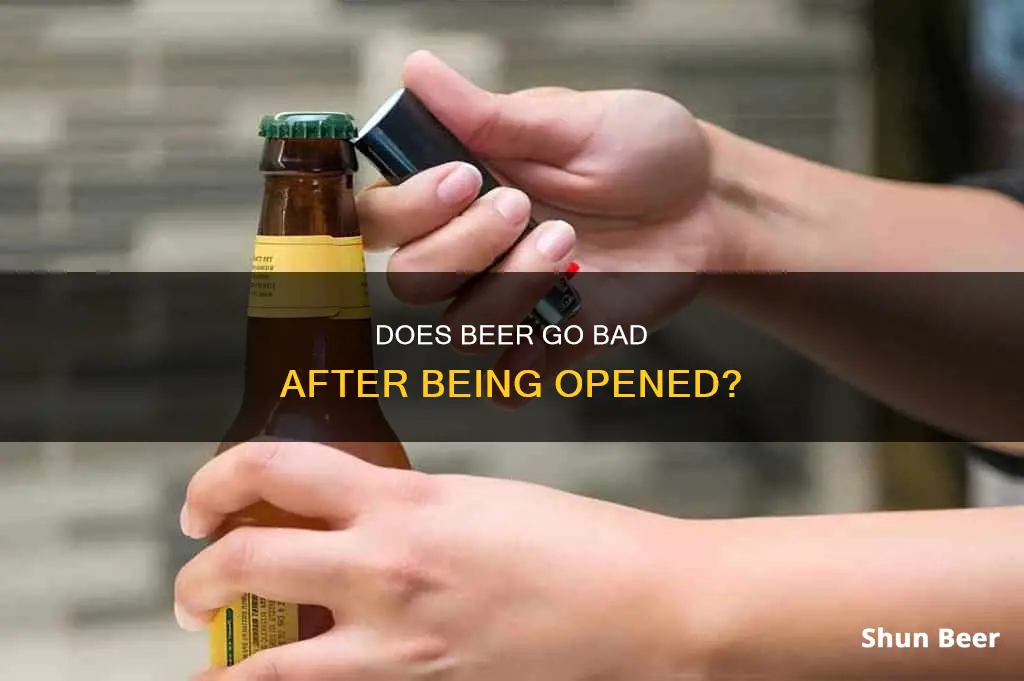
Beer is a beloved beverage for many, but what happens when you don't finish that bottle or can and leave it out for a couple of days? Can you still drink it? The answer is yes, but there are some important things to consider. Firstly, beer is highly susceptible to oxidation, which will cause a change in taste. Secondly, the longer an open beer is left out, the more it will lose its carbonation, resulting in a flat beverage.
To prevent these issues, it's recommended to reseal the container as tightly as possible and store the beer in a cool, dark place like a refrigerator. Even with proper storage, beer is best consumed within 1 to 2 days of opening to ensure optimal taste and quality. After that, the beer will likely be safe to drink but may have lost its carbonation and have a less pleasant flavour.
Additionally, it's important to check for signs of spoilage before consuming, such as an unpleasant odour or taste, cloudiness, or visible mould. If any of these indicators are present, it's best to discard the beer.
What You'll Learn

Beer's shelf life
Beer does expire, but it doesn't become unsafe to drink. Its taste, however, will change. Stored properly, an old beer will have the same effect on your body as a freshly packaged beer.
The shelf life of beer varies depending on the type and storage conditions. Most beers are best consumed within 6 to 9 months if stored at room temperature. Refrigeration can extend this period to up to 2 years. Unpasteurized or craft beers may have a shorter shelf life.
Beer stored in a refrigerator can last up to an additional two or three years. This applies to bottled beer, cans, growlers, etc. Unopened, of course. Opened beer has a shelf life of about a day or two, regardless of the expiration date listed.
Temperature plays a pivotal role in determining a beer's shelf life. If you store it in a warm place above room temperature, its freshness will decrease quickly. On the other hand, storing it in a refrigerator prolongs its freshness. Ideally, you should store beer at typical refrigerator conditions—35°F and 46°F.
Light exposure, especially UV rays, can cause beer to develop a skunky odor and taste. This is more prevalent in beers packaged in clear or green bottles. Brown bottles offer better protection, and cans completely shield beer from light, helping to preserve its quality longer.
Oxygen exposure is another significant factor affecting beer's shelf life and quality. When oxygen comes into contact with the beer, it can cause oxidation, degrading the beverage's flavour and changing its colour. Bottled beer is more susceptible to oxygen exposure than canned beer.
Signs that your beer has gone bad include an unusual smell, such as skunk or urine, or strange tastes, such as metallic, sour, or cardboard-like flavours. Cloudiness can also indicate spoilage or bacterial contamination.
To extend the shelf life of beer, store it in a cool, dry place, away from temperature fluctuations and direct sunlight. Keep it upright to minimize oxidation and avoid exposing it to UV rays.
Beer and Bowel Movements: The Poop Float Mystery
You may want to see also

Factors affecting beer's shelf life
The shelf life of beer can vary depending on several factors, including packaging types, storage conditions, and the type of beer. Here are some key considerations to keep in mind:
- Packaging Types: Canned beer generally has a longer shelf life than bottled beer due to better protection from light exposure and oxygen, which are factors that contribute to spoilage. Dark bottles offer some protection against ultraviolet rays, but amber or green bottles are recommended for even better protection.
- Storage Conditions: Beer should be stored in a cool, dark place, away from direct sunlight and heat sources. The ideal temperature range for storing beer is between 45-55°F (7-13°C). Storing beer in a refrigerator can extend its shelf life up to two years.
- Beer Styles: Not all beers have the same shelf life. Hoppy beers, lagers, and ales typically have a shorter shelf life, while darker or aged beers, such as stouts, porters, barley wines, and Belgian ales, tend to last longer. Beers with lower alcohol content have a shelf life of up to 6 months, while those with higher alcohol content can last up to 1-2 years.
- Temperature Fluctuations: Avoid exposing beer to temperature fluctuations as it can negatively impact its quality and taste. Beer stored at room temperature will last for about 5 to 9 months, while refrigerated beer can last for 2 to 3 years.
- Oxygen Exposure: Oxygen exposure can cause oxidation in beer, leading to flavour degradation and colour changes. Storing beer upright helps minimize the surface area exposed to oxygen, preserving freshness.
- UV Rays: Sunlight and UV rays can cause beer to spoil more quickly and develop a skunky odour and taste. Dark bottles offer some protection, but cans are the best option for minimizing light exposure.
- Expiration Dates: Beer companies usually provide expiration dates or "best before" dates on their packaging. While the beer may still be drinkable past this date, its taste and quality may deteriorate over time.
By understanding and optimizing these factors, you can prolong the freshness and enhance the drinking experience of your beer.
Lovastatin and Beer: A Safe Mix?
You may want to see also

Signs of spoilage
Beer is a delicate beverage, and its flavour can be affected by various factors, including oxygen, heat, and light. While drinking a two-day-old open beer is unlikely to cause any health issues, it may not taste as good as a fresh beer. Here are some signs of spoilage to look out for:
Unpleasant Flavour and Odour
The most obvious sign of spoilage is a strange taste or smell. Oxidation caused by oxygen exposure can give the beer a papery or cardboard-like flavour. Beer can also develop a "skunky" taste and smell if exposed to UV light. Other off-flavours include sourness, metallic or cardboard-like flavours, and bitterness. If your beer tastes or smells strange, it's best to discard it.
Cloudiness and Haze
Cloudiness or haze in beer can be a sign of bacterial contamination. While not all cloudy beers are spoiled, it is best to look for other signs of spoilage, such as unusual flavours and odours. If the beer has a cloudy appearance along with strange tastes or smells, it is likely spoiled.
Mould Growth
Mould thrives in damp, dark places, so beer should be stored in a cool, dry place away from direct sunlight. If mould is visible in the beer, it is definitely spoiled and should not be consumed.
Loss of Carbonation
Beer is considered "flat" when its carbonation level rises, resulting in a lack of bitterness and sharpness. Flat beer will have a dull, unpleasant flavour. This can happen when the beer is exposed to oxygen or left open for too long.
Vinegar Taste
If your beer has a tangy or vinegary taste, it is a sign that bacteria have contaminated it. This is more common in beers that are not meant to be acidic or tangy.
Excessive Sediment
Checking the bottom of the bottle for excessive sediment can also help determine if the beer has gone bad. While a small amount of sediment is normal in some beers, excessive sediment can contribute to a poor taste.
It is important to note that the shelf life of beer can vary depending on the type of beer, storage conditions, and other factors. To extend the shelf life of an open beer, it is recommended to store it in an airtight container in the refrigerator.
Drinking Beer as a Passenger: What's the Legal Verdict?
You may want to see also

How to extend shelf life
Beer has a shelf life of around two days before it loses its flavour significantly. However, it is still drinkable after being opened for 24-48 hours, although it will be flat and stale. To extend the shelf life of beer, follow these steps:
Find the Perfect Storage Spot
Store beer in a cool, dry place with temperatures between 35 and 55 degrees Fahrenheit (2 to 13 degrees Celsius). Avoid areas prone to temperature fluctuations, such as near windows or heating vents. Keep the beer away from direct sunlight and UV rays, which can cause flavour degradation. If possible, always store beer in a refrigerator to slow down flavour degradation.
Keep the Beer Sealed and Upright
Properly seal beer bottles or cans after opening to prevent oxygen exposure, which causes the beer to go bad faster. Store the beer upright rather than on its side to minimise the surface area exposed to oxygen, preserving its freshness.
Avoid Temperature Fluctuations
Avoid exposing beer to rapid temperature changes, as this can negatively impact its quality and taste. Do not freeze and thaw beer, as it affects its carbonation levels, taste, and facilitates spoilage. Choose a shaded area with stable temperatures when storing beer outdoors. Use a cooler or insulated bag to protect the beer from extreme temperatures during transport.
Use Airtight Containers
To prevent oxidation and loss of carbonation, transfer leftover beer to airtight containers or beverage canisters. You can also use recycled plastic soda bottles, ensuring they are sealed tightly.
Add Sterile Beer Salts
Adding a few drops of sterile beer salts to the beer can help create an environment where germs cannot thrive. This is especially beneficial for stronger alcoholic brews, which are more prone to oxidation than lighter beers.
Is Barq's Root Beer Safe for Pregnant Women?
You may want to see also

What to do with leftover beer
Beer is a versatile beverage that can be used for everything from home improvement projects to adding flavour to your favourite foods. Here are some ways to put leftover beer to good use:
Cooking
Leftover beer can be used in a variety of cooking applications. Beer can be used as a cooking liquid for braising, steaming, and more. It can also be used to create light and airy fried foods and baked goods, as the carbonation in beer makes it a great ingredient for batters. Beer can be added to cake batter, or used to create a sweet, malty loaf of bread. It can also be used to make a pan sauce for sautéed chicken or pork, or added to virtually any stock to create a boozy soup or stew.
Cleaning
Beer can be used as a stain remover on carpets and other surfaces. Simply pour flat beer over the stain and rub it in. Beer can also be used to restore dull wood, adding a new lustre to wooden furniture.
Pest Control
Beer can be used to trap and kill insects. Pouring stale beer into buckets and placing them around the perimeter of a backyard gathering, for example, will attract and trap flies and mosquitoes.
Hair Care
The vitamin B and sugars in beer can add shine and volume to hair. Saturating freshly washed hair with beer and then rinsing it out with cold water can lead to gorgeous locks.
Other Uses
In addition to the above, beer can be used as a metal de-rusting agent, and can even be added to shampoo for extra shine and volume.
The Science of Sipping: Beer Steins Explained
You may want to see also
Frequently asked questions
Beer that has been opened for two days is typically safe to drink but may have lost some of its flavour and freshness. It is recommended to drink within 24-48 hours for optimal taste and quality.
There are a few signs to look out for when it comes to beer spoilage. These include an unpleasant odour, such as a skunk or urine smell, an unusual taste, and cloudiness. If you notice any of these, it's best to discard the beer.
To prolong the freshness of an open beer, it is recommended to store it in an airtight container in the refrigerator. Minimising exposure to oxygen, heat, and light will help to slow down the oxidation process and maintain its flavour and quality.







